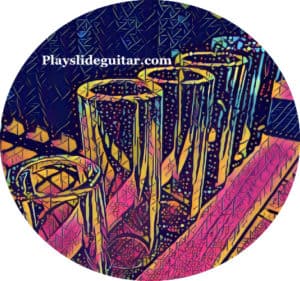As an Amazon Associate Playslideguitar.com earns from qualifying purchases. This page contains affiliate links.
There are many types of slides for guitar, and choosing the right slide material, weight, and size can be helpful for your playing. But first, you’ll want to determine the best finger to wear the slide on for your playing style.
Most players will place the slide on either their middle, ring, or pinky finger. These fingers allow you to control the slide for movements along the fretboard, to dampen strings behind the slide with your other fingers, and to sustain notes while adding vibrato.
There are certain advantages and disadvantages to using each finger, and understanding the differences can be beneficial for developing your playing technique. Let’s take a closer look at determining which finger to place the slide on when playing slide guitar…
What You Need To Know Before Choosing: Playing Techniques and Styles
Although a lot of your choice will come down to preference and playing goals, it is helpful to understand the main factors that go into choosing a finger to place the slide on. You’ll want the slide to feel comfortable on your finger, but you’ll also want to make sure you are able to develop good playing techniques as you use it.
Your middle and ring fingers are often naturally more coordinated, and can be good to use for controlling the slide. However, a variety of factors goes into the techniques involved with your left hand when playing slide guitar and you’ll want to consider these when choosing which finger to place the slide on.
Dampening the Strings
For whichever finger you place the slide on, you’ll need to make sure that you have other fingers available on that hand to rest on the strings behind the slide to dampen them. This is crucial for slide guitar technique, otherwise unwanted tones and noises will be heard as you play.
Because of this, you don’t usually want to wear the slide on your index finger. Although the index finger is very dexterous and coordinated compared to some other fingers, it isn’t going to allow you to easily dampen the strings between the slide and the nut of the guitar.
Often times, placing the slide on the ring or pinky fingers will give you the most control over dampening strings in this manner, as your index and middle fingers (and ring finger if the slide is on your pinky) can easily be extended and rested on the strings behind the slide.
Sustain, Control, and Vibrato
A large part of your slide guitar playing and technique revolves around sustaining notes by applying pressure against the strings with the slide, which is also important for creating vibrato. Furthermore, the amount of control you have over the slide when sustaining notes in a position on the fretboard is important, and can be affected by which finger you place the slide on.
Most players find it easier to sustain notes effectively, and add vibrato, when they use their middle or ring finger to hold the slide. Because the pinky isn’t usually as naturally coordinated as these other two fingers, most players gravitate towards another finger.
However, sometimes placing the slide on the pinky finger can provide more stability and control if the other fingers are anchored against the slide as they rest on the strings to dampen them.

The middle finger can often feel the most coordinated, and thus seem like the best option for using the slide, however this only provides your index finger for dampening the strings behind the slide. This can make controlling the slide with this finger a little more difficult.
Oftentimes, the ring finger is a favorite choice to place the slide on because it provides a nice balance of coordination (slide control) and dampening the strings with ease.
Having the Option To Fret Notes With Other Fingers
If your guitar’s action is low enough, you’ll be able to fret notes with your fingers like regular guitar even if you’re wearing a slide on a finger. Although this can be challenging to do, it can be a great way to add more options to your slide playing without having to take the slide off of your finger and place it somewhere as you play.
By making sure the slide doesn’t touch strings that you are fretting with your fingers, you can still utilize many of your regular guitar playing techniques and then use the slide whenever you’d like. Some players will even fret notes with their fingers and use the slide to voice other notes simultaneously.
If you do decide to fret notes while wearing a slide, it can be helpful to place the slide on a finger that is easy to hold over the strings while your other fingers are fretting notes. This can be a matter of personal preference and finger dexterity, as the middle, ring, and pinky fingers all allow this playing technique.
How To Choose Which Finger To Place The Slide On
Usually the best way to determine which finger to use is to experiment with each one as you practice. By trying out each finger, and keeping certain techniques and goals in mind, you’ll likely be able to narrow down which one works best for you.
As you try using the slide on each possible finger, be aware of the various playing techniques mentioned earlier. Ask yourself:
- How easy is it to dampen the strings with the slide on this finger?
- Do I feel like I have a good sense of control with the slide for vibrato and movement along the fretboard?
- Am I still able to fret notes with my other fingers if I’d like to?
- Does this finger feel natural in terms of the angle it meets the strings? Am I able to use the slide on this finger in a comfortable and relaxed manner?

Comfort and Flexibility: Finding A Finger That Feels The Most Natural
Ultimately, your decision will come down to a variety of factors. However, the best choice for you personally may be to use whichever finger feels most natural to you for wearing the slide on.
If one finger allows you to play more comfortably, and with more fluidity and flexibility while moving along the fretboard, then you’ll probably have better control over the slide because of this. It can be helpful to have your hand and fingers as relaxed as possible as you play slide guitar, and if one finger curls and meets the fretboard more naturally than the others, then it may be the best choice.
Slide guitar techniques can feel challenging as you develop your playing, so it isn’t always easy to relax your left hand no matter what finger the slide is placed on. However, if you find that the majority of the techniques mentioned earlier are easier to do with one finger compared to others, then this is probably your best choice for moving forward as you play.
Of course, you can always switch it up and use different fingers for various playing situations. But you’ll likely find that there is a certain finger on your left hand that you prefer to use dominantly in your slide guitar playing.
Check out the article below for more info on slides, and how to find one that works well for you…
